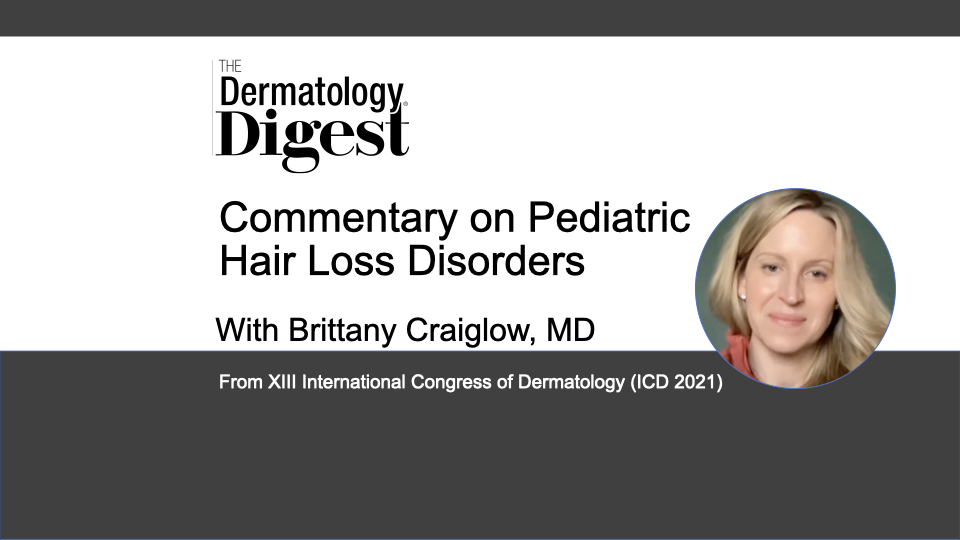Brittany Craiglow, MD, is Associate Professor Adjunct, Yale School of Medicine, New Haven, Connecticut.
“It’s easy for people to… tell kids, ‘Oh, you can wear a hat or you can wear a wig, but it’s dramatically life altering for patients and families. There’s a huge impact on quality of life,” said Brittany Craiglow, MD, who presented “Paediatric Hair Loss Disorders” at the XIII International Congress of Dermatology (ICD 2021).
“You really can’t interact with the world in a normal way if you don’t have hair. You just can’t,” she said.
According to Dr. Craiglow, alopecia areata and androgenetic alopecia are the two most common causes of pediatric hair loss and, until recently, dermatologists have neither had effective treatment options nor anything that’s been FDA approved for children.
“In terms of alopecia areata, there’s been a lot of data now for the use of JAK inhibitors.1 There are lots of clinical trials in adult populations.”
One trial included children 12 and older, she pointed out. “But lots of [pediatric] patients now have been treated off label. There are case series and case reports of kids taking these medicines for hair loss, for alopecia areata, and doing very well.”
Oral minoxidil is another treatment option slowly making its way into pediatric use for androgenetic alopecia, said Dr. Craiglow who has used it in teenagers to treat the hair loss disorder.
“I’m also starting to use it a little bit in kids with alopecia areata, so kind of a new tool for the toolbox for these kids, for whom there aren’t many options.”
Research also suggests that dupilumab may be an effective option for children with both alopecia areata and atopic dermatitis.
“I published a case series2 recently of six kids who had both atopic dermatitis and alopecia areata treated with dupilumab, five of whom regrew [hair] nearly completely,” she said.
In another recent study,3 researchers found dupilumab effective in patients with a history of atopic dermatitis or with elevated IgE.
Because dupilumab is on-label for atopic dermatitis in children, it’s something you can also access more easily for alopecia areata patients, said Dr. Craiglow.
“Up to 30% of patients with alopecia areata also have atopic dermatitis… so it’s something to think about.”
The importance of recognizing the ill effects of hair loss in children and how it affects patients and families can’t be overemphasized, said Dr. Craiglow.
“Plenty of people cope. …they live their life fairly normally, but it’s still there. It’s always there. Even if you’re wearing a wig, you’re thinking, is it going to come off? Are people looking at my hairline? Can you tell I’m wearing it? You can’t go swimming, or you can’t play basketball… it’s a big thing.”
There is a complicated psychology that goes along with hair loss, said Dr. Craiglow. Take some extra time with these patients and assure the family that their feelings are valid.
“I think just taking a little extra time with these patients. Try to imagine if it were our child or, you know, family member. How would we want to be treated? …It’s hard. In the middle of a busy clinic, it takes longer but …it’s really rewarding. I think a lot of people shy away from [treating] hair loss because … often the visits are longer, there aren’t necessarily a lot of things [you can] do, but if you can help somebody get their hair back, they’re eternally grateful. There’s really nothing like it.”
References
- Hamilton CE, Craiglow BG. JAK Inhibitors for the Treatment of Pediatric Alopecia Areata. J Investig Dermatol Symp Proc. 2020 Nov;20(1):S31-S36. doi: 10.1016/j.jisp.2020.04.005. PMID: 33099381.
- Cho SK, Craiglow BG. Dupilumab for the treatment of alopecia areata in children with atopic dermatitis. JAAD Case Rep. 2021 Jul 27;16:82-85. doi: 10.1016/j.jdcr.2021.07.015. PMID: 34541272; PMCID: PMC8435985.
- McKenzie PL, Castelo-Soccio L. Dupilumab therapy for alopecia areata in pediatric patients with concomitant atopic dermatitis. J Am Acad Dermatol. 2021 Jun;84(6):1691-1694. doi: 10.1016/j.jaad.2021.01.046. Epub 2021 Jan 20. PMID: 33484763.


